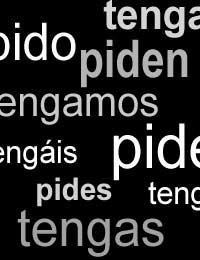Irregular Verbs in Spanish

Some irregular verbs display the same irregularities, so that if you know one you can predict the forms of any of the others in the same group.
There’s no real magic trick with irregular verbs – they just need to be learned. As you become more experienced with using Spanish, the more the right verb form will come naturally.
Radical Changing Verbs
The biggest group of predictably irregular Spanish verbs are called radical changing, or sometimes stem changing.
In some verbs the stem (i.e the first part of the verb) changes when stressed, depending on the person and tense.
There are three main types of these sorts of verbs:
Type 1: -ar and –er Verbs
The changes occur only in the present tenses (subjunctive and indicative), when the stem is stressed. In practice, this means all three singular forms and the third person plural form. The other forms do not change. The ‘e’ in the stem becomes ‘ie’, the ‘o’ becomes ‘ue’, as does the ‘u’ – although in fact this only applies to the verb ‘jugar’ (to play.)
So ‘pensar’ (to think) in the present indicative is as follows:
pienso, piensas, piensa, piensan
And in the present subjunctive: piense, pienses, piense, piensen
Have a look at volver (to return):
Present indicative: vuelvo, vuelves, vuelve, vuelve, vuelven
Present subjunctive: vuelva, vuelvas, vuelva, vuelva, vuelvan
And note the stem change in the verb jugar, to play:
Present indicative: juego, juegas, juega, juegan
Present subjunctive: juege, jueges, juege, juegen
Type 2: - ir Verbs
These kinds of Spanish verbs,like mentir, to lie and dormir, to sleep, have the same changes in the same places as above. But, additionally, there is a stem change from ‘e’ to ‘i’ and ‘o’ to ‘u’ in the following tenses:
Gerund (remember this translates as ‘-ing’ in English) – mintiendo, durmiendo.
Present subjunctive (first and second person plural forms) – mintamos, mintáis; durmamos, durmáis
Preterite (third person, both singular and plural) – mintió, durmió
Type 3: - ir Verbs
Verbs of this type have the stem change in the same way as the second type, but this always from ‘e’ to ‘i’.
A good example is the verb ‘pedir’ – to ask for or request.
Present indicative: pido, pides, pide, piden
Present subjunctive: pida, pidas, pida, pidamos, pidáis, pidan
Gerund : pidiendo
Preterite : pidió, pidieron
Irregular ‘g’ Verbs
There is a group of words in which the stem of the present indicative contains ‘g’ in the first person singular form only, and throughout the present subjunctive.
Some have a regular present indicative tense apart from the first person – others have stem changes.
Here’s an example – a very common verb, ‘hacer’, which means to do or to make.
Present indicative: hago, haces, hace, hacemos, hacéis, hacen
Present indicative: haga, hagas, haga, hagamos, hagáis, hagan
Tener, to have, again, an extremely commonly used verb:
Present indicative: tengo, tienes, tiene, tenemos, tenéis, tienen
Present indicative: tenga, tengas, tenga, tengamos, tengáis, tengan
The following verbs all have a similar pattern:
Caer – to fall
Poner – to put
Salir - to go out
Valer - to be worth
Decir - to say
Oír - to hear
Irregular ‘zc' Verbs
Another pretty large group with an irregular first person singular form in the present indicative are verbs whose infinitives end in –ecer, -ocer, and –ucir.
The stem of the first person form of the present indicative, and so all of the present subjunctive forms, ends in ‘zc’.
Parecer (to seem)
Present indicative: parezco, pareces, parece, parecemos, pareceís, parecen
Present subjunctive: parezca, parezcas, parezca, parezcamos, parezcáis, parezcan
The following verbs follow the same pattern:
Conocer – to know, to get to know
Reconocer – to recognise
Aparacer – to appear
Desaparacer – to disappear
Ofrecer - to offer
Conducir - to drive, conduct or lead
Producir – to produce
Irregular ‘oy’ Verbs
In these verbs, the first person singular form of the present indicative ends in ‘oy’. This does not affect any subjunctive forms.
The verb ‘dar’, to give, is an example: doy, das, da, damos, dais, dan
Note also the verb ‘estar’, one of two Spanish verbs to be: estoy, estás, está, estáis, estamos, están.
- How to Learn Future Tense in Spanish
- Spanish Words to Watch Out For
- The Subjunctive in Spanish
- The Past Imperfect Tense in Spanish
- The Conditional Tense in Spanish
- The Past Preterite Tense in Spanish
- Personal Pronouns in Spanish
- The Infinitive in Spanish
- Ser and Estar in Spanish
- The Present Tense in Spanish
- Por and para in Spanish
- Accents in Spanish
- Personal a in Spanish
- Adjectives in Spanish
- Gender of Nouns in Spanish


Re: Spanish Phrases for Hotels
Hi, I work in a hotel in the US. I'm trying to learn phrases in Spanish to speak to my Spanish speaking guests. Phrases…
Re: Spanish Numbers Days and Months
How do you say the twelfth month in Spanish. Not the month itself. Just that phrase
Re: Personal Pronouns in Spanish
How come vosotros isn't in the subject pronouns?
Re: The Influence of Spanish on English
I have found this website very useful and the present article has helped me a lot in understanding the influence of…
Re: The Past Preterite Tense in Spanish
magb123 - Your Question:You have a typo on 'ser'. The first person singular is 'fui' not 'fu'Our Respo
Re: The Past Preterite Tense in Spanish
you have a typo on 'ser'. The first person singular is 'fui' not 'fu'
Re: Spanish Numbers Days and Months
I´m spanish, i could give custom classes to anyone interested.
Re: The Past Preterite Tense in Spanish
Some typos on this otherwise excellent page: "Ponder" for poder and "fu" for fui. You need a proofreader.
Re: Colours in Spanish and How They Are Used
i really found this site very helpful as a college student! thanks